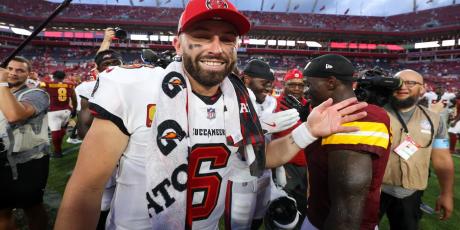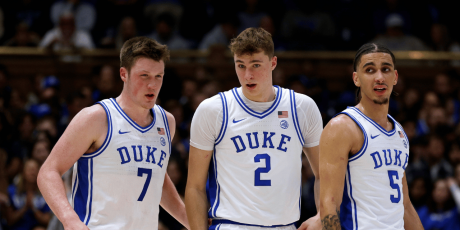When Should You Draft Your Running Back?

Running backs are extremely valuable in 2017 MFL10s — just ask anyone who drafted David Johnson or Le’Veon Bell last season. You have to start two each week (or three with the flex) so rostering five to six RBs is probably necessary no matter where you draft them. Before we get into my preferred MFL10 strategy, let’s look at a few directions you could go at RB in 2017.
-
Early-Round RB – With this strategy, you select three to four running backs through the first five rounds. By implementing this strategy, you can probably stop at five total running backs, freeing up roster spots for other positions. Running backs have a relatively high chance of getting injured or under-performing, but taking on some extra risk by investing heavily in one position may be necessary in a league where you are shooting for first place.
-
Studs and Duds – A mix of a few top running backs with wide receivers through the first five or six rounds. This gives you the flexibility to grab the best player available as they drop, especially if you have a pick in the middle of the round.
-
Wait on RB – With this strategy you load up on wide receivers through the early rounds, maybe taking just one running back through your first five or six picks. The key to this approach is securing upside later with running backs who catch passes. In theory, you will have wide receivers that are so good you usually just need serviceable weeks from your running backs.
Be Wary of the False Sense of Security of Drafting RBs Early
Most MFL10 leagues are filled with fantasy owners that try to acquire at least two RBs in the first four rounds. These owners feel they have an early lead, so to speak, when they draft two or three elite rushers — but all they really have is a false sense of security at football’s most fragile position!
The early-round RB crowd that is aware of the risks involved at the RB position often draft handcuffs or other viable options to back up their stud RBs later in the draft. One way or another, they often end up spending the rest of their draft protecting their perceived lead at RB through fear instead of focusing on upside in this top-heavy payout structure.
Meanwhile, sharp drafters are subtly overtaking the RB hoarders by loading up on assets that shore up their weaknesses, without diminishing their strengths — and at the same time likely securing more upside.
You want to draft in a way that actually gives your team a chance to improve throughout the season. It’s called contingency-based drafting, where you build in as much flexibility and as many options as you can while also building in as much upside as possible. In essence, it's the Zero RB draft strategy.
This strategy allows you to take advantage of overzealous RB drafters by stockpiling high-upside WRs and setting your team up to improve over the course of the season while your competitors' teams decline as the season wears on.
Antifragility and Contingency-Based Drafting
Whether you decide to exercise the Zero RB strategy or not, you should always try and build in as much flexibility as you can and as much upside as possible. Zero RB just happens to be the best way to do this in MFL10s.
Zero RB allows you to benefit from randomness as opposed to being a victim of it. There are a lot of unnecessary pressures people put on themselves by taking RBs in the early rounds. RBs touch the ball more than WRs, and therefore get injured more. They're also more interchangeable because a lot of RB success depends on volume and offensive line play.
Contingency-based drafting is all about benefiting from the chaos of the RB position. As the season goes on, the landscape can change very quickly, whether due to injuries, depth chart changes, unexpected breakouts, or other factors. You can actually draft in a way that benefits from this chaos and sets your team up to get better — in other words drafting to be antifragile.
Zero RB teams are very antifragile, and that's a huge positive. Early-round RB teams are merely resilient, at best. Antifragile rosters are often able to overcome the resiliency of early-round RB rosters. Early RB teams will inherently tend to have weaker WRs, so they will need to deploy a RB in the FLEX more often. Beyond the fact that in this day and age most WRs will outscore RBs at similar ADP, it's also true that owners who draft RBs early often see their team suffer from a lack of depth and upside. They fear that their stud RB will go down which causes them to forgo a lot of league-winning upside by trying to protect their expensive RB assets.
What Types of RBs to Target for Zero RB
It is no secret that the NFL is turning into more of a passing league. You probably know that rushing is not as efficient as passing on a pure per-attempt basis -- that is, a passing play averages more yardage than a rushing play.
This doesn’t mean running the ball is useless -- it is imperative in real football. However, gaining smaller chunks of yardage at a time is not efficient in fantasy football, either.
Fantasy football is still about discovering what players, and what types of players, will give you the most points.
Targeting RBs who catch a lot of passes is ideal. With spread offenses becoming more and more common, a RB who can catch passes out of the backfield and make plays in space is becoming more and more valuable every year.
Also, any RB that will run behind a strong offensive line is in play, even if you're not crazy about the RB's actual talent.
One difference between MFL10s and season-long leagues is that in MFL10s you don’t have the ability to work the waiver wire. One way to combat this is to focus on drafting players who may be one injury or poor performance away from a three-down role. You’re looking for players who can carry the load, but also offer the versatility to stay on the field in all types of game script and situations.
Even if more people overcorrect back to a RB-heavy approach this year because of the success of last year’s mega-studs, the “optimal” way to win an MFL10 in 2016 could easily differ in 2017. Either way, RBs will still go too early and other favorable players will still drop. Because of this, Zero RB probably carries the most upside but it may be a riskier strategy in best-ball because you can't always count on your middle- and late-round draft shots at RB to hit. That said, in a top-heavy prize format such as MFL10s, that type of upside is very valuable.
"The frequency of correctness does not matter; it is the magnitude of correctness that matters." — Michael J. Mauboussin
Editor's Note: Subscribe now and get an early-bird discount on 4for4's 2017 Classic, Pro, or DFS products!
Related Articles
- When Should You Draft Your Quarterback?
- How Often do Top-12 PPR Running Backs & Wide Receivers Repeat in the Following Season?
- Tips From Top Players: MFL10 Strategy with Mike Beers and Josh Hornsby
- Tips From Top Players: MFL10 Strategy with Pat Thorman and Rumford Johnny
- Tips From Top Players: MFL10 Strategy with Jen Ryan and Heath Cummings
- Tips From Top Players: MFL10 Strategy with 14TeamMocker and Scott Barrett
- Optimal MFL10 Roster Construction: Part 2
- Optimal MFL10 Roster Construction: Lessons Learned in 2016
- An Intro to MFL10 Draft-Only Leagues: Prizes, Rules & Basic Strategy


















